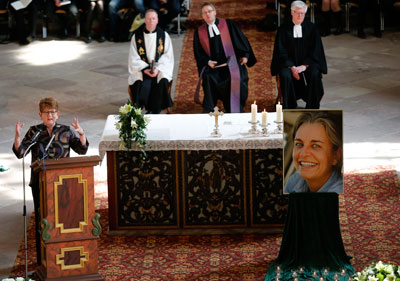Naqibullah, the Afghan police commander who killed The Associated Press’ Anja Niedringhaus, has been given a death sentence after being convicted of murder and treason. He was also given a four- year sentence for shooting the AP’s Kathy Gannon. Naqibullah (who goes by one name, as many Afghans do) opened fire at near-point-blank range on the AP photographer/reporter team in the southeastern city of Khost on April 4, 2014, as they were covering preparations for the first round of voting in Afghanistan’s still-contested presidential elections. Wednesday’s conviction and sentencing were the first steps along the legal path to a final conviction and sentence, which might not come for years.
The AP reported that the judges’ ruling came down in a two-hour session. Naqibullah’s lawyer argued that his client might not be mentally stable, but was overruled. The judges felt that if the defendant could identify himself, give his age, and knew what day it was, he was competent enough to be tried and sentenced.
So, in this one case of Afghan violence, the issue of justice for the killer of a journalist has been addressed. Since 1992, when CPJ started keeping track, at least 26 journalists, Afghan and international, have been killed in the country. To my knowledge, a trial, let alone a conviction, has never happened before. As a matter of fact, it seldom happens anywhere in the world. We do not track accountability in all types of journalists’ deaths, but in murders, the perpetrator is not brought to justice 88 percent of the time. And while CPJ doesn’t gloat over death sentences, the fact that justice has been handed down in this case should be a cause for celebration.
And yet it’s not. Anja Niedringhaus is gone. Kathy Gannon is still recovering. I didn’t know Niedringhaus, but by all accounts she was not just a great photographer, but a terrific, dynamic person. Gannon I’ve met a few times, in Islamabad, and we’ve been exchanging email messages on and off for the past eight years, ever since I’ve been at CPJ. She understood fully what CPJ is about, and always spoke admiringly of the work we do.
I can recall discussing with her, in a hotel coffee shop in Islamabad, her approach to the risks of working in the field in Pakistan and Afghanistan. Back then I had raised the issue of protective gear with her. She was fearless, but not fatalistic or blasé, in her barebones approach to personal security, and had been operating that way for years. But, given the facts of the Khost shooting, including that they were traveling under the protection of Afghan forces and the attack took place outside a police station, it’s hard to imagine either Gannon or Niedringhaus escaping serious injury no matter what protection they used.
The exceptional thing about journalists’ deaths in Afghanistan is that so many of the victims are not Afghan– a pattern that is opposite of everywhere else in the world. CPJ data show that 88 percent of all the journalists killed globally are local journalists covering local stories. In Afghanistan, 69 percent of those killed were not Afghans, but foreigners. And a considerable number of the Afghans died while working for foreign media–a difference I’ve written about a few times before. Local reporters are by far the most likely to be killed, and Afghanistan is an exception: Gannon, I’m sure, understands both those realities and all their implications. Everything I’ve heard about Niedringhaus makes me believe she was well aware of it too.
